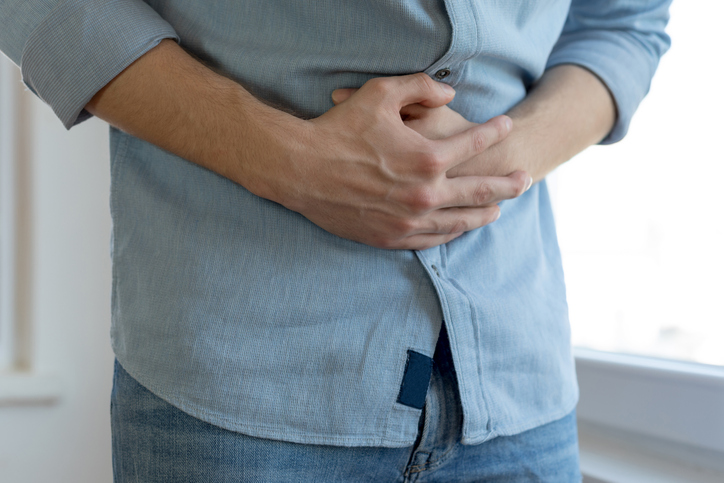Pain
Pelvic Pain in Men

Pelvic pain is a broad term used to describe pain felt below the belly button and above the legs. Pain located in this region can indicate the presence of a medical condition and may occur on one or both sides of the body. Pelvic pain can be acute (sudden and severe) or chronic (intermittent or constant and long- lasting) and can occur for no known reason. Chronic pelvic pain is diagnosed when pelvic pain lasts longer than six months. If an individual is experiencing pelvic pain that does not go away or worsens, they should be evaluated by a physician. To determine the cause of pelvic pain, diagnostic tests may be ordered including, but not limited to, ultrasound, blood testing, CT scan, MRI, X-ray, laparoscopic surgery or colonoscopy.
Causes of pelvic pain in men
- A hernia occurs when an organ or tissue pushes through a weak spot in the abdomen, normally creating a painful bulge. Coughing, laughing, bending over or lifting causes hernia pain to worsen. Symptoms include a feeling of heaviness, weakness or pressure in the area of the hernia or pain and swelling around the testicles.
- Irritable bowel syndrome (IBS) can cause abdominal pain, gas, mucus in the stool, cramps, bloating, diarrhea and/or constipation. Treatment includes diet changes and medications. A bowel movement may ease symptoms of IBS.
- Bacterial prostatitis is a bacterial infection which causes inflammation and swelling of the prostate gland. Symptoms include frequent urination, painful urination, fever, chills, nausea, vomiting, fatigue and the inability to urinate.
- Urinary tract infection (UTI) can develop when bacteria enter the urinary tract. Symptoms include frequent urination, sensations of a full bladder after urination, pain while urinating, strong-smelling urine, back or side pain, fever, nausea, vomiting and pelvic pain. A UTI can cause a serious infection if it spreads to the kidneys.
- Chronic pelvic pain syndrome presents as long-term (three months or longer) pelvic pain with no obvious cause or infection present. Pain is normally felt in the testicles, penis, lower abdomen and perineum (the area between the testicles and rectum). Symptoms include painful urination, slow urine stream, frequent urination, muscle pain, fatigue, joint pain and painful ejaculation.
- Appendicitis normally presents as a sharp pain in the lower right abdominal area and worsens with deep breathing, coughing or sneezing. Symptoms include nausea, vomiting, fever, abdominal swelling and constipation or diarrhea. Emergency treatment is essential as appendicitis can lead to a burst appendix which can quickly spread infection throughout the body.
- Post-vasectomy pain syndrome can develop after a man has a vasectomy and pain remains present three months or longer after the procedure. Causes include structural damage to a testicle or pressure on the nerves in the area. Symptoms include pain during erection, painful intercourse or painful ejaculation. The pain may be sharp, stabbing, throbbing, constant or intermittent.
- Pudendal nerve entrapment or pudendal neuralgia (PN) occurs when an injury, surgery or growth puts pressure on the pudendal nerve, entrapping it. The pudendal nerve delivers sensations to the genitals, anus and urethra. Pain ensues in the genitals, around the rectum and the perineum. Symptoms include a shocking or deep aching pain when sitting, problems urinating, frequent urination, constipation, painful bowel movements, trouble getting an erection and numbness in the penis and scrotum.
- Kidney stones develop when salts and minerals, normally eliminated during urination, become wedged in the bladder, kidney or urinary tract. Pelvic pain is usually severe when the stones move through the ureter. Symptoms include blood in the urine, cloudy urine, pain during urination, nausea, vomiting, foul-smelling urine, urgency to urinate, fever and chills. Medical treatment should be sought if a kidney stone is suspected.
- Interstitial cystitis (IC) is caused by inflammation of the bladder. Symptoms include frequent urination, bladder pressure, painful urination, strong-smelling urine, bloody urine, low-grade fever and pain in the scrotum, testicles or penis.
- Surgery performed in the abdominal area can cause pain or infection. Scar tissue and adhesions often form inside the body after surgery and can cause organs to become fused resulting in pelvic pain. Adhesions are common and do not always cause pain. However, when the intestines become fused and a blockage occurs, pain may be severe. Symptoms include nausea, vomiting, abdominal swelling, constipation and loud noises emanating from the bowels. Emergency treatment is essential if these symptoms occur.
- Sexually transmitted diseases (STDs), such as chlamydia or gonorrhea, are bacterial infections transmitted during sexual activity and can cause pain during urination. Symptoms include, but are not limited to, testicle pain, rectal pain, penis discharge, tenderness or swelling of testicles, pus in the urine and frequent urination.
- Urethral stricture is the narrowing or blockage of the urethra as a result of swelling, injury or infection. Symptoms include painful urination, slow urine stream, blood in the urine or semen, penis swelling, inability to control the bladder and urine leakage.
- Benign prostatic hyperplasia (BPH), common in older men, is the noncancerous enlargement of the prostate gland. The prostate grows as men age and puts pressure on the urethra. The bladder muscles then weaken as they have to work harder to push out urine. Symptoms include a full feeling in the pelvis, urinary urgency, weakened urine flow, problems beginning urination and straining to urinate.
- Cancers of the prostate, testicles and penis may cause pelvic pain. Symptoms include, but are not limited to, frequent urination, weak urination stream, urine leakage, inability to urinate while standing, blood in the urine, blood in the semen, decreased ejaculation fluid, painful ejaculation, trouble getting an erection and pain or stiffness in the lower back, hips, pelvis or thighs.





